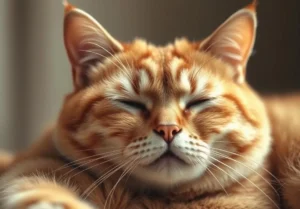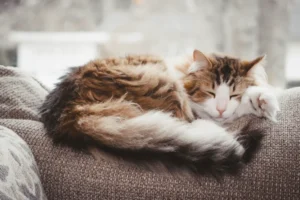
Cats and their quirky sleeping positions can leave us scratching our heads and worrying in equal measure. Just caught your feline friend snoozing face down and panicked about whether it’s normal? You’re in the right place for some peace of mind.
By the end of this blog post, you’ll understand why your cat chooses such an odd position and how it impacts their well-being.
Quick Takeaways:
- Cats sleeping face down is normal and often a comfortable position for them, leveraging their instinctual behaviors.
- Sudden changes in sleeping patterns or positions, coupled with signs of distress or discomfort, warrant a quick vet visit.
- Enhance your cat’s sleeping experience with a warm, soft bed in a quiet, cozy spot, and observe their behavior for signs of health issues.
Is It Normal for Cats to Sleep Face Down?
Yes, absolutely! Cats are renowned for their flexibility and ability to sleep in a myriad of positions, face down included. This peculiar position, while it might look uncomfortable to us, can be quite normal for our feline friends. Cats in the wild sleep in positions that allow them to spring into action quickly, and sleeping face down might be a carryover from this instinctual behavior. So, when you see your kitty snoozing with their face pressed into the bed or couch, know that they’ve simply found their personal sweet spot for a nap.
What Does Sleeping Face Down Indicate About a Cat’s Health?
While the face-down sleep position is typically normal, it can sometimes raise flags about your cat’s health. A sudden change in sleeping habits warrants attention. If your cat, who normally sprawls out in the open, suddenly starts hiding and sleeping with their face down in secluded spots, it might be a sign of discomfort or illness, possibly aiming to hide their vulnerability.
Here’s a quick guide to when you might want to be concerned:
- Sudden Change: A drastic or sudden change in sleep position, especially coupled with other behavior changes.
- Discomfort Signs: Look out for signs of discomfort when your cat is awake, such as limping, reluctance to jump, or decreased appetite.
- Respiratory Issues: If sleeping face down seems to aid their breathing, it could indicate respiratory distress.
Should any of these signs accompany the face-down sleeping position, it’s worth a check-up with your vet. However, if your cat seems healthy, happy, and their usual self, but simply prefers snoozing face down, chances are it’s just their personal preference for comfort.
How Can Comfort Influence a Cat’s Sleeping Position?
Comfort is king for cats, especially when it comes to their sleeping spots. Cats will often opt for the warmest, coziest place they can find – be it a sunny windowsill, a fluffy cushion, or even a laptop keyboard. If your cat chooses to sleep face down, it might be because that position feels particularly secure or warm to them.
Here’s how you can enhance their sleeping experience:
- Warm Bedding: Consider a cat bed with raised edges. The raised sides provide a sense of security and can offer a snug spot for face-down sleeping. The Purrfect Cloud Luxe Bed is a cozy option that many cats seem to love.
- Quiet Space: Cats often prefer quiet, undisturbed areas for their deep slumber. Providing a secluded spot away from the hustle and bustle can make all the difference.
- Temperature: Keep your home at a comfortable temperature. Remember, cats seek out warm spots, so if your house is on the cooler side, they might find unique positions to conserve body heat.
Remember, each cat has its unique personality and preferences. The goal is to observe and learn what makes your kitty most comfortable, then try to accommodate those needs as best you can. Sleeping face down is just one of the many quirks of cat behavior that makes them such fascinating companions.
Does Sleeping Face Down Affect a Cat’s Breathing?
When your feline friend curls up face down into what might look like an unconventional snooze posture, it’s hard not to wonder if they’re getting the rest they need or if they’re somehow compromising their ability to breathe easy. Let’s dive into whether this charming behavior is something to fret over.
Cats are known for their flexible and varied sleeping positions, but when it comes to sleeping face down, the concern among pet owners is whether this cute quirk impacts a cat’s breathing. Generally, cats are quite adept at picking positions that keep them comfortable and their airways clear, even if it looks peculiar to us humans. However, it’s worth noting that certain breeds may face more challenges than others due to their unique facial structures. Brachycephalic cats, such as Persians and Himalayans, have shorter nasal passages that can make breathing more difficult, especially in positions that might restrict airflow further.
For most cats, though, snoozing face down doesn’t pose significant risks to their respiratory functions. They’re incredibly intuitive about their needs and comfort, often shifting positions throughout their naptime to keep things just right. Yet, it’s always best to stay observant and ensure that our furry companions are as comfortable and healthy as possible.
What Can You Do to Ensure Your Cat’s Comfort?
Creating a cozy and safe sleeping haven for your cat, especially if they fancy dozing face down, involves a mix of observation and providing the right amenities. Here’s how you can help:
- Choose the right bedding: Opt for a soft, plush bed that conforms to your cat’s preferred sleeping position. Memory foam beds are particularly effective as they adapt to your cat’s body, providing both comfort and support.
- Maintain a comfortable environment: Keep your cat’s sleeping area in a quiet, warm part of your house where they can relax without disturbances.
- Observe their behavior: Keep an eye on how your cat likes to sleep and make adjustments to their sleeping area accordingly. If they frequently sleep face down, a round or oval-shaped bed might mimic their natural curling position.
Interestingly, one unique tip that most cat owners might not consider is integrating an elevated platform in their cat’s sleeping area. Cats naturally seek high ground when they feel threatened or stressed. An elevated bed or a cat tree with a comfortable sleeping nook can provide a secure and fascinating vantage point for your cat to lounge and observe their surroundings, potentially reducing the urge to sleep in tightly curled positions that might restrict breathing.
When to Consult a Vet About Your Cat’s Sleeping Habits
Cats are creatures of comfort, often finding the most peculiar positions to rest in. However, it’s crucial to recognize when a sleeping habit might signal something more concerning. Here are signs that it’s time to chat with your vet:
- Sudden changes in sleeping positions: If your cat abruptly stops sleeping in their favorite positions or seems uncomfortable while resting.
- Difficulty breathing: Look out for signs of labored breathing, especially if your cat continues to sleep face-down despite showing discomfort.
- Lethargy or decreased activity: If your cat seems more tired than usual or uninterested in activities they usually enjoy.
- Changes in behavior or appetite: Significant shifts in behavior or eating patterns can indicate underlying issues that need professional attention.
Remember, you know your cat best. If something feels off, it’s better to be safe and seek a professional opinion. Cats are masters of disguise, often hiding discomfort or illness, so your observations are crucial for their well-being.
In wrapping up, while cats sleeping face down is mostly a whimsical quirk, it’s a reminder of how nuanced and unique our feline companions can be. By staying observant and providing a comfy spot for their snoozing adventures, we ensure our cats not only sleep well but stay healthy and happy.
Alex, a passionate animal lover, has experience in training and understanding animal behavior. As a proud pet parent to two dogs and three cats, he founded AnimalReport.net to share insights from animal experts and expand his knowledge of the animal kingdom.




